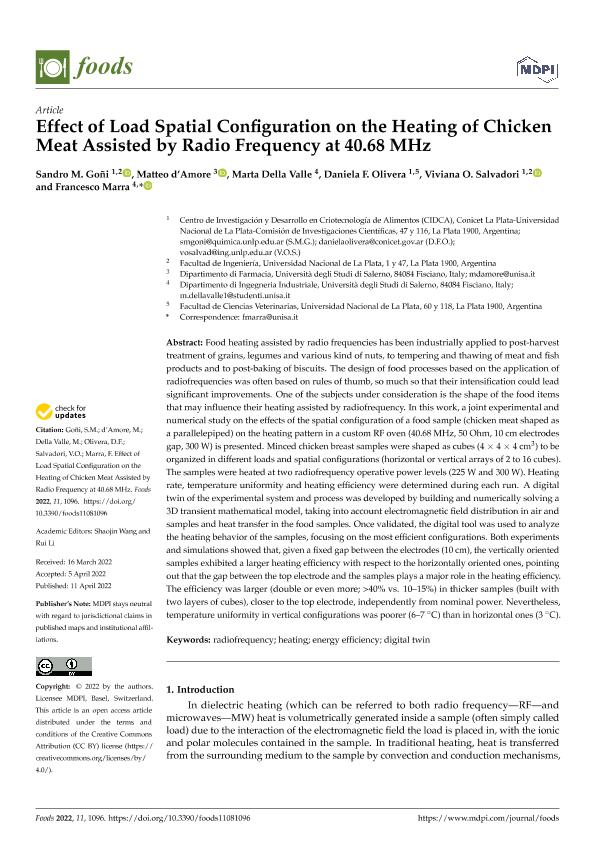Mostrar el registro sencillo del ítem
dc.contributor.author
Goñi, Sandro Mauricio

dc.contributor.author
d'Amore, Mateo
dc.contributor.author
Della Valle, Marta
dc.contributor.author
Olivera, Daniela Flavia

dc.contributor.author
Salvadori, Viviana Olga

dc.contributor.author
Marra, Francesco
dc.date.available
2023-05-16T14:56:23Z
dc.date.issued
2022-04
dc.identifier.citation
Goñi, Sandro Mauricio; d'Amore, Mateo; Della Valle, Marta; Olivera, Daniela Flavia; Salvadori, Viviana Olga; et al.; Effect of load spatial configuration on the heating of chicken meat assisted by radio frequency at 40.68 MHz; Multidisciplinary Digital Publishing Institute; Foods; 11; 1096; 4-2022; 1-18
dc.identifier.issn
2304-8158
dc.identifier.uri
http://hdl.handle.net/11336/197712
dc.description.abstract
Food heating assisted by radio frequencies has been industrially applied to post-harvest treat-ment of grains, legumes and various kind of nuts, to tempering and thawing of meat and fish products and to post-baking of biscuits. The design of food processes based on the application of radiofrequencies was often based on rules of thumb, so much so that their intensification could lead significant improvements. One of the subjects under consideration is the shape of the food items that may influence their heating assisted by radiofrequency. In this work, a joint experi-mental and numerical study on the effects of the spatial configuration of a food sample (chicken meat shaped as a parallelepiped) on the heating pattern in a custom RF oven (40.68 MHz, 50 Ohm, 10 cm electrodes gap, 300 W) is presented. Minced chicken breast samples were shaped as cubes (4 × 4 × 4 cm3) to be organized in different loads and spatial configurations (horizontal or vertical arrays of 2 to 16 cubes). The samples were heated at two radiofrequency operative pow-er levels (225 W and 300 W). Heating rate, temperature uniformity and heating efficiency were determined during each run. A digital twin of the experimental system and process was devel-oped by building and numerically solving a 3D transient mathematical model, taking into ac-count electromagnetic field distribution in air and samples and heat transfer in the food samples. Once validated, the digital tool was used to analyze the heating behavior of the samples, focus-ing on the most efficient configurations. Both experiments and simulations showed that, given a fixed gap between the electrodes (10 cm), the vertically oriented samples exhibited a larger heat-ing efficiency with respect to the horizontally oriented ones, pointing out that the gap between the top electrode and the samples plays a major role in the heating efficiency. The efficiency was larger (double or even more; >40% vs. 10?15%) in thicker samples (built with two layers of cu-bes), closer to the top electrode, independently from nominal power. Nevertheless, temperature uniformity in vertical configurations was poorer (6?7 °C) than in horizontal ones (3 °C).
dc.format
application/pdf
dc.language.iso
eng
dc.publisher
Multidisciplinary Digital Publishing Institute
dc.rights
info:eu-repo/semantics/openAccess
dc.rights.uri
https://creativecommons.org/licenses/by-nc-sa/2.5/ar/
dc.subject
RADIOFREQUENCY
dc.subject
HEATING
dc.subject
EFFICIENCY
dc.subject
DIGITAL TWIN
dc.subject.classification
Otras Ingeniería Química

dc.subject.classification
Ingeniería Química

dc.subject.classification
INGENIERÍAS Y TECNOLOGÍAS

dc.title
Effect of load spatial configuration on the heating of chicken meat assisted by radio frequency at 40.68 MHz
dc.type
info:eu-repo/semantics/article
dc.type
info:ar-repo/semantics/artículo
dc.type
info:eu-repo/semantics/publishedVersion
dc.date.updated
2023-04-27T18:31:12Z
dc.journal.volume
11
dc.journal.number
1096
dc.journal.pagination
1-18
dc.journal.pais
Suiza

dc.journal.ciudad
Basilea
dc.description.fil
Fil: Goñi, Sandro Mauricio. Provincia de Buenos Aires. Gobernación. Comisión de Investigaciones Científicas. Centro de Investigación y Desarrollo en Criotecnología de Alimentos. Consejo Nacional de Investigaciones Científicas y Técnicas. Centro Científico Tecnológico Conicet - La Plata. Centro de Investigación y Desarrollo en Criotecnología de Alimentos. Universidad Nacional de La Plata. Facultad de Ciencias Exactas. Centro de Investigación y Desarrollo en Criotecnología de Alimentos; Argentina
dc.description.fil
Fil: d'Amore, Mateo. Universita di Salerno; Italia
dc.description.fil
Fil: Della Valle, Marta. Universita di Salerno; Italia
dc.description.fil
Fil: Olivera, Daniela Flavia. Provincia de Buenos Aires. Gobernación. Comisión de Investigaciones Científicas. Centro de Investigación y Desarrollo en Criotecnología de Alimentos. Consejo Nacional de Investigaciones Científicas y Técnicas. Centro Científico Tecnológico Conicet - La Plata. Centro de Investigación y Desarrollo en Criotecnología de Alimentos. Universidad Nacional de La Plata. Facultad de Ciencias Exactas. Centro de Investigación y Desarrollo en Criotecnología de Alimentos; Argentina
dc.description.fil
Fil: Salvadori, Viviana Olga. Provincia de Buenos Aires. Gobernación. Comisión de Investigaciones Científicas. Centro de Investigación y Desarrollo en Criotecnología de Alimentos. Consejo Nacional de Investigaciones Científicas y Técnicas. Centro Científico Tecnológico Conicet - La Plata. Centro de Investigación y Desarrollo en Criotecnología de Alimentos. Universidad Nacional de La Plata. Facultad de Ciencias Exactas. Centro de Investigación y Desarrollo en Criotecnología de Alimentos; Argentina. Universidad Nacional de La Plata. Facultad de Ingeniería; Argentina
dc.description.fil
Fil: Marra, Francesco. Universita Di Salerno. Facolta Di Ingegneria; Italia
dc.journal.title
Foods
dc.relation.alternativeid
info:eu-repo/semantics/altIdentifier/doi/https://doi.org/10.3390/foods11081096
dc.relation.alternativeid
info:eu-repo/semantics/altIdentifier/url/https://www.mdpi.com/2304-8158/11/8/1096
Archivos asociados
